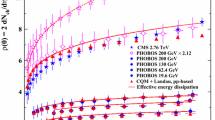Summary
A simple model for inelastic nucleus-nucleus collisions at high energies is proposed. Predictions are summarized in approximate, but simple, scaling laws that directly relate hadron production in high-energy nucleus-nucleus collisions to hadron production in high-energy nucleon-nucleon collisions. The possible use of nucleus-nucleus collisions to investigate future energy domains of particle physics with present accelerators is emphasized.
Riassunto
Si propone un modello semplice per le collisioni anelastiche nucleo-nucleo ad alte energie. Si riassumono le predizioni in leggi di scala approssimate, ma semplici, che mettono direttamente in relazione la produzione di adroni in collisioni nucleo-nucleo ad alta energia con la produzione di adroni in collisioni nucleone-nucleone ad alta energia. Si pone l’accento sul possibile uso di collisioni nucleo-nucleo ad alta energia per studiare futuri domini dell’energia nella fisica delle particelle con i presenti acceleratori.
Реэюме
Предлагается простая модель для неупругих соударений ядер с ядрами при высоких знергиях. Предскаэания сводятся к приближенным, но простым эаконам скейлинга, которые непосредственно свяэывают рождение адронов в соударениях ядер с ядрами при высоких знергиях с рождением адронов в нуклон-нуклонным соударениях при высоких знергиях. Обсуждается воэможность испольэования соударений ядер с ядрами для исследования будуших знергетических областей на сушествуюших ускорителях.
Similar content being viewed by others
References
A. M. Baldin, N. Giodrenescu, V. N. Zubarev, L. K. Ivanova, N. S. Moroz, A. A. Povtoreiko, V. B. Radomanov andV. S. Stavinskii:Yad. Fiz.,20, 1201 (1974) (English translation:Sov. Phys. Nucl. Phys. 20, 629 (1975));A. M. Baldin:Proceedings of the VI International Conference on High-Energy Physics and Nuclear Structure, Santa Fe, June 1975, and references therein.
H. H. Heckman: inHigh-Energy Physics and Nuclear Structure, edited byG. Tibell (Amsterdam, 1974), p. 403;J. Papp, J. Jaros, L. Schroeder, J. Staples, H. Steiner, A. Wagner andJ. Wiss:Phys. Rev. Lett.,34, 601 (1975);J. Papp: Ph. D. Thesis, University of California, Berkeley, Cal., 1975 (unpublished).
G. Berlad, A. Dar andG. Eilam:Phys. Rev. D,13, 161 (1976);
Y. Afek, G. Berlad, G. Eilam andA. Dar:Phys. Rev. D,15, 2622 (1977);Phys. Rev. Lett.,37, 947 (1976); PH-76-48 (to be published inNucl. Phys., B). For relevant ideas see also
F. C. Roesler andC. B. A. McCusker:Nuovo Cimento,10, 127 (1953);
W. Heitler andC. H. Terreaux:Proc. Phys. Soc.,66 A, 929 (1953);
D. S. Narayan andK. V. L. Sarma:Progr. Theor. Phys.,31, 93 (1964);
L. D. Landau: inCollected Papers of L. D. Landau, edited byD. Ter Haar (London, 1965);
K. Gottfried: inHigh-Energy Physics and Nuclear Structure, edited byG. Tibell (Amsterdam, 1974);
A. Dar:Proceedings of the ICTP Topical Meeting on High-Energy Reactions Involving Nuclei (Trieste, 1974);
A. Z. Patashinskii:JETP Lett.,19, 338 (1974);
F. Takagi:Lett. Nuovo Cimento,14, 559 (1975);
S. Fredriksson:Nucl. Phys.,11 B, 167 (1976);
Men Ta-Chung: Freie Universität Berlin, preprint ITP-SB-76-7 (January 1976).
A recent analysis ofE. Albini, P. Capiluppi, G. Giacomelli andA. M. Rossi:Nuovo Cimento,32 A, 101 (1976), indicates that the available laboratory energyE a=√s−(m beam+m target) is a better universal parameter than the c.m. energy.
If the incident energy is not sufficiently high, then it is better to use the available energy rather than the centre-of-mass energy as the universal parameter of the CTM. (See for instance ref. (3b).) In this paper we discuss only collisions at very high energies such that the centre-of-mass energy and the available energy are equal.
In ref. (3a,3b) we have found that the substitutionA 1/31 for the average over the nucleon number of the tubes is a good approximation both in the independent-particle model and in the hard-sphere model of the nucleus.
Expression (5″) needs some modification before applying it to the experimental data of ref. (2). These modifications result from the recommended use of the available energy as the universal parameter of the CTM at «low» energies. Due to lack of space they will be discussed elsewhere.
E. Albini, P. Capiluppi, G. Giacomelli andA. M. Rossi:Nuovo Cimento,32 A, 101 (1976).
Author information
Authors and Affiliations
Additional information
Work supported in part by GSI, Gesellschaft für Schwerionenforschung, MBH Darmstadt and by the Israel Commission for Basic Research.
In partial fulfillment of the requirements for the D. Sc. degree.
Rights and permissions
About this article
Cite this article
Afek, Y., Berlad, G., Eilam, G. et al. Inclusive production of hadrons in nucleus-nucleus collisions at high energies. Nuov Cim A 43, 485–494 (1978). https://doi.org/10.1007/BF02730443
Received:
Published:
Issue Date:
DOI: https://doi.org/10.1007/BF02730443




